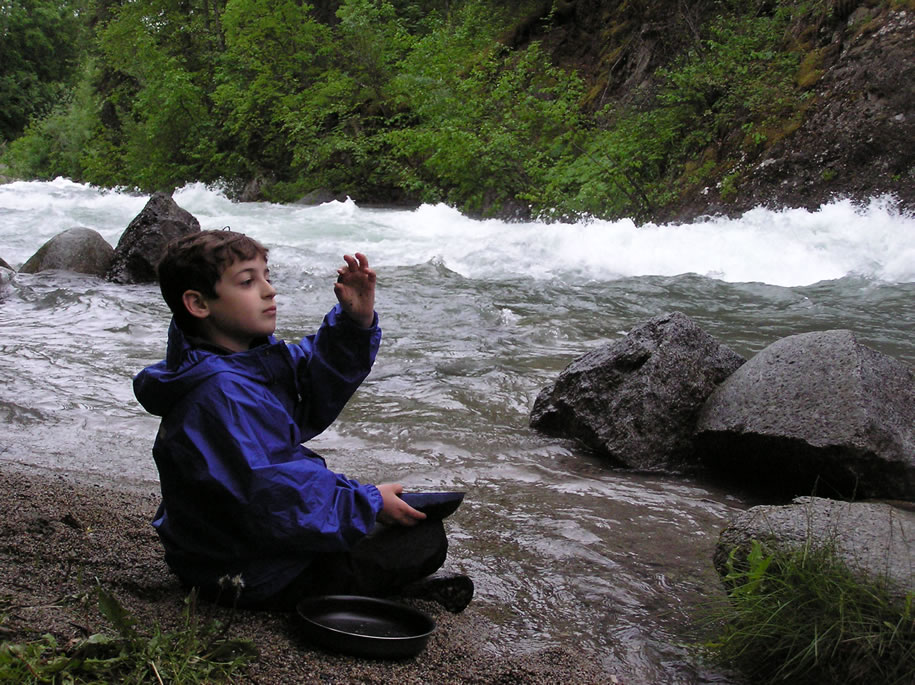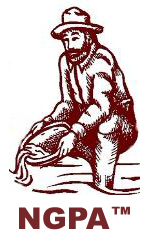The First Time I Found Gold Prospecting

My name is Patrick and I have been prospecting since 1980. However, I’ve had the fever since I was a young boy of six years old. It all started when my father told my brother and me the story of how he and his family had seen a mountain of silver in the Wyoming/Montana country back in the early 1900’s. As the story goes, they were traveling across the country in an old wagon to settle in the state of Washington. The story was made even more captivating to my young brother and me by the fact that it was being told by my father as he held a quart jar filled with gold and silver ore from one of the many old mines in Washington. Oh, yes, “the fever” was born in me.
Getting back to more modern times, I must tell you that I would be best described as your “meat and potatoes” kind of miner. I make my home out on the river, panning and hand sluicing between one and three pennyweight on an average day, and am happy doing it. That being said, on with the story.
In the winter of 1985, an old prospecting friend, whose path I had crossed many times in our respective pursuits for the elusive gold, bought a house in the old mining town of Dutch Flat, California, about midway between Sacramento, California and Reno, Nevada, on Interstate 80. This area is renowned for being rich in gold, much of which has been found in the Yuba River tertiary channel, or ancient riverbed, which runs from Iowa Hill in the south to North San Juan, or Malakoff Diggings in the north. In places the channel is fully a mile wide. Many tons of gold have been borne from this channel, with many remaining for those with ‘the fever’ to find it.

My first nice find took place in one of the heavier gold-producing mines known as the Polar Star Mine, understandably one of the richest of all of the California mines. Polar Star Mine was one of the very few mines in the area that had been hydraulically stripped down to bedrock.
At this point, some directions might be in order. Exiting to Dutch Flat off of Interstate 80, following the signs to the store, you are only a stone’s throw away. You will find the original store, hotel, school, post office, and women’s club intact, just as they were in the Gold Rush days. Even the ancient and somewhat spooky graveyard remains just as it was during the early Gold Rush era.
While I don’t know the entire history of the town, there are many who do, and who are eager to spin tales of the past. But, back to the directions. Between the Post Office and the antique store is a nondescript road leading to the diggings. The road winds from the store to the Dutch Flat Power House down on the Bear River, and I have been told that if you follow it the entire length, it will eventually lead you to Grass Valley or Nevada City but like many of the stories surrounding mining, don’t quote me, or depend on this. Many of the creeks and streams along this road bear gold, but it is always best to check for claims.
Back to the Polar Star. Starting at the post office, follow this road for 3/4-mile or so, and just after the place where the mountain drops off several hundred feet on your left side, you will come upon a hole or mine shaft running into the side of the mountain. If you get to the switchback in the road, you have gone too far. The hole is pretty prominent, measuring approximately 10 feet wide by 7 feet tall, running nearly 100 yards through the ridge. It did then, and still does today, hold the sluice box for the Polar Star Mine.
Back in the 1800’s when hydraulic mining was still legal, the common practice was to hydraulically unearth tons of gold-bearing gravel down through this sluice and out the side of the mountain, allowing it to fall several hundred feet into the Bear River below. Today, the Bear River still bears the scars of hundreds of feet of overburden over the natural river bed. Fortunately, mining laws have been revised and amended to prohibit the use of hydraulics, thereby preserving the environment. This is where my story begins.
As I said earlier, my friend had bought a house, and I was recruited to help him move and get settled. I took advantage of the opportunity to hike and scout the nearby creek and river systems, testing for gold. I was pleased to discover that every stream in the area bore color.
Having been to the Polar Star sniping for nuggets on previous occasions, I had been in the tunnel a time or two with a flashlight. On each occasion mercury was present. November of 1985 was one of the rainiest months on record. On this particular day I was feeling adventurous and decided to see what the tunnel held. I equipped myself with my 3-foot aluminum sluice box, shovel, bucket, and lantern, and off I went.
Once in the tunnel you can see the original Polar Star sluice box which, after more than 100 years, is almost intact – a fine example of the craftmanship that was the pride and hallmark of our forefathers. Some of the redwood floorboards were 15 feet long by 3 feet wide by 2 inches thick, and are as solid today as the day they were installed with such precision that it is impossible to work a razor blade between the seams of the adjacent planks. There was the occasional crack, rotted spot, or rusted nail hole that one would certainly expect after a century–but, for the most part, the condition remained excellent. The rain had provided 3 or 4 inches of water running through the center, which was just enough to work my sluice box nicely.
Moving to the top of the tunnel, I began to displace rock and debris. Immediately after moving some of the rock and debris, I began to see mercury and amalgamated gold. What a sight! I quickly moved down to position myself near the second board of the sluice box and cleared a spot so that my own aluminum sluice box could sit flat on the bottom board. I redirected the water in such a way that anything that came from above would have to pass through my sluice. Additionally, I angled the box in such a way that the mercury would collect in one corner. Once the mercury reached the top of the first riffle and threatened to spill over, a simple turkey baster served as the ideal instrument to retrieve it and deposit it into a container.
After finally clearing off the first board, I cleaned one of the shorter ones (approximately 12 feet by 3 feet by 2 inches), and taking it up, I found puddles of gold amalgamate and mercury underneath. Most were sitting atop a silt/clay layer. My trusty turkey baster again served me well in removing it.
That first day I pulled out 3/4-ounce of gold dust and three pounds of mercury. In a period of ten days, stretched over the course of a month (after all, I was supposed to be helping my friend with his house), I took out a total of 1-1/4 pounds of gold and 15 pounds of mercury!
Continuing with the procedure I had used on the first two boards, I removed each separate board of the sluice box, replacing each after cleaning on top and beneath it, so that the gold amalgamate and mercury would continue to flow after a heavy rain.
With the hope of someday returning to this spot, and for the benefit of my fellow prospector, I left a substantial amount of gold in the rocks at the top of the tunnel. As a matter of fact, if someone were resourceful enough to devise a way to utilize a small dredge without succumbing to carbon monoxide poisoning, there is easily 4 or 5 pounds for the taking.

